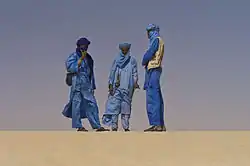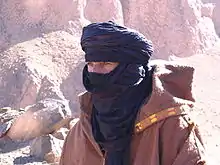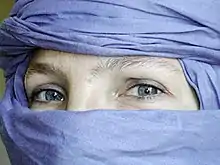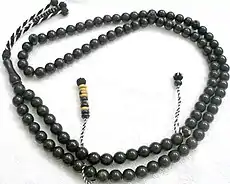Tagelmust
The tagelmust (also known as cheich, cheche and litham) is an indigo-dyed cotton garment, with the appearance of both a veil and a turban. The cloth may exceed ten meters in length. It is mostly worn by Tuareg Berber men, the Hausa of the far northern Sahel region and the Songhai. In recent times, other colors have come into use, with the indigo veils saved for use on special occasions. It usually has many layers that cover the head, and it drapes down to loosely cover the neck. It is also worn by some French people as a scarf.



The tagelmust covers the head. It prevents the inhalation of wind-borne sand by its wearers in the Sahara region.[1] The indigo is also believed by many of the wearers to be healthy and beautiful, with a buildup of indigo in the skin of the wearer being generally considered to protect the skin, and denote affluence.[2] Because of the scarcity of water, the tagelmust is often dyed by pounding in dried indigo instead of soaking it. The dye often permanently leaches into the skin of the wearer, and because of this, the Tuareg are often referred to as the "blue men of the desert".[3]
Among the Tuareg, men who wear the tagelmust are called Kel Tagelmust, or "People of the Veil".[4] The tagelmust is worn only by adult males, and only taken off in the presence of close family. Tuareg men often find shame in showing their mouth or nose to strangers or people of a higher standing than themselves, and have been known to hide their features using their hands if a tagelmust is unavailable. The tagelmust has other cultural significance, as the manner in which it is wrapped and folded is often used to show clan and regional origin, and the darkness to which it is dyed showing the wealth of the wearer.
See also
References
| Wikimedia Commons has media related to Cheche. |
- Chris Scott Budget Travel (2007-03-16). "The Sahara: Dry but never boring". Cnn.com. Retrieved 2014-01-27.
- Balfour-Paul, Jenny (1997). Indigo in the Arab world (1. publ. ed.). London: Routledge. p. 152. ISBN 978-0-7007-0373-9.
- "Tuareg". Newsfinder.org. 2002-06-16. Retrieved 2014-01-27.
- "Indigenous Peoples of the World — the Tuareg". Archived from the original on July 19, 2007. Retrieved 2007-04-03.CS1 maint: bot: original URL status unknown (link)
- Philippi, Dieter (2009). Sammlung Philippi: Kopfbedeckungen in Glaube, Religion und Spiritualität. St. Benno Verlag, Leipzig. ISBN 978-3-7462-2800-6.

